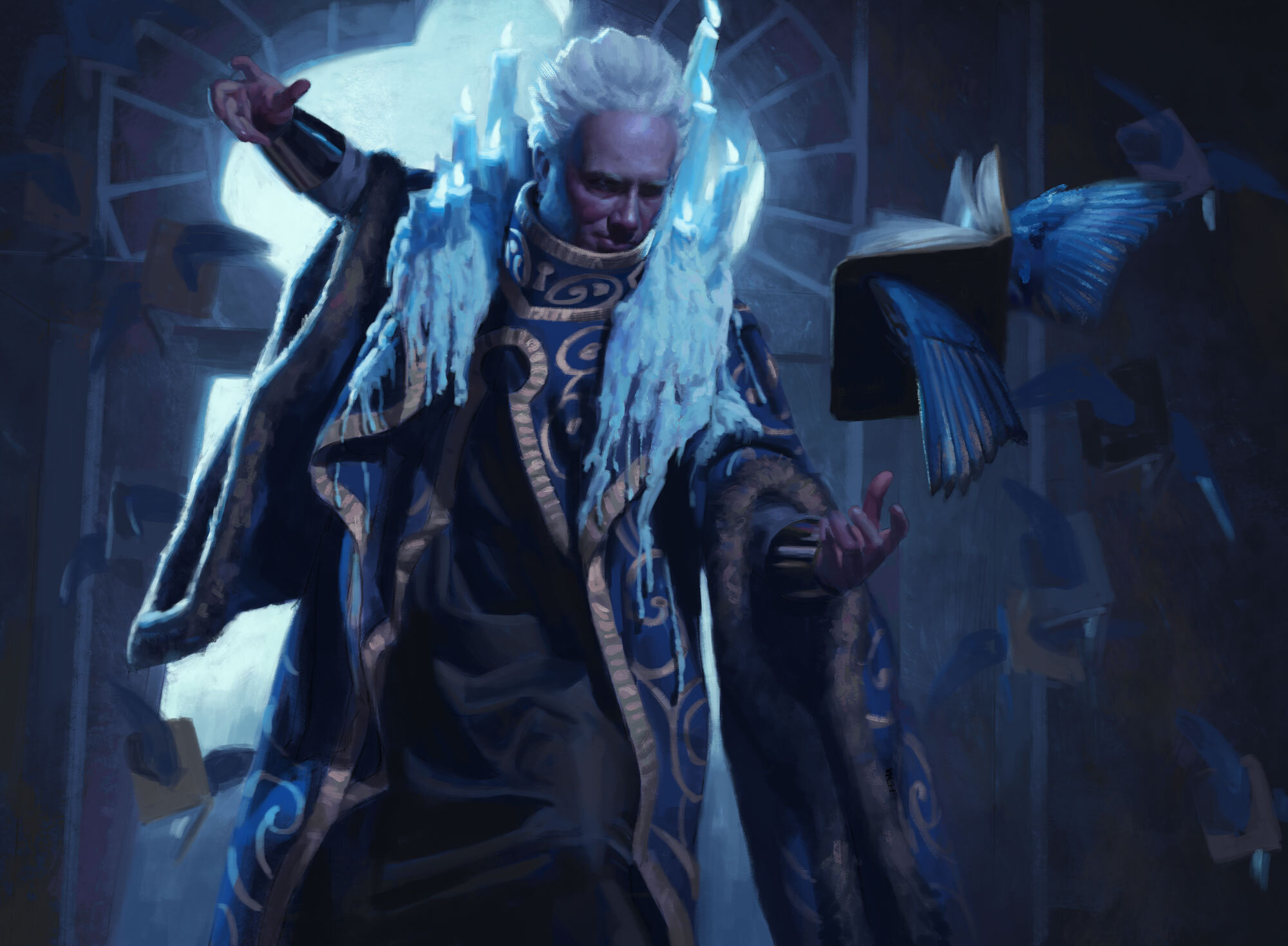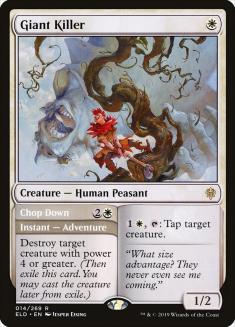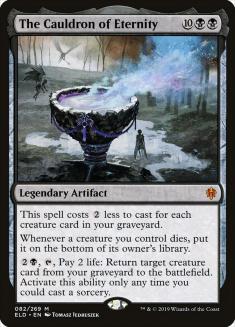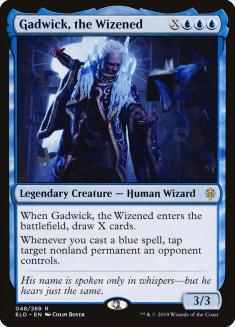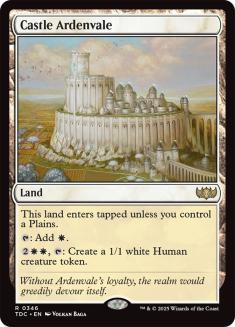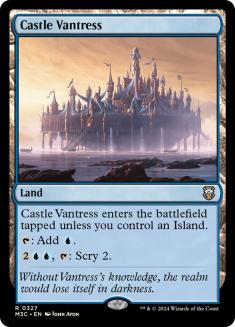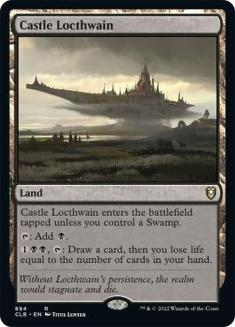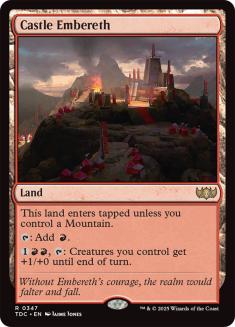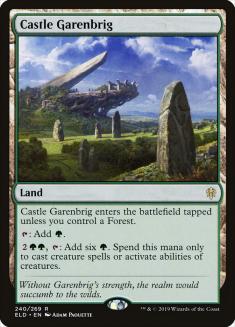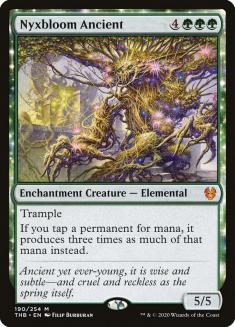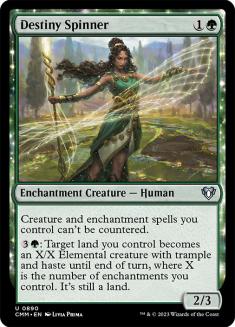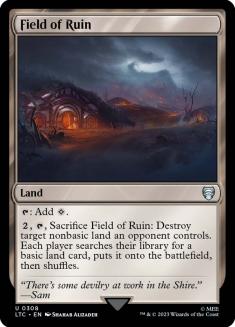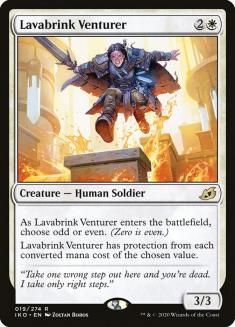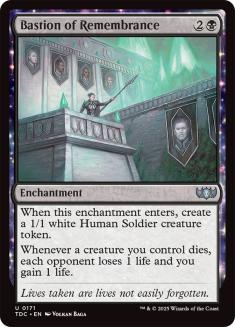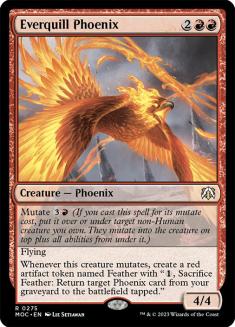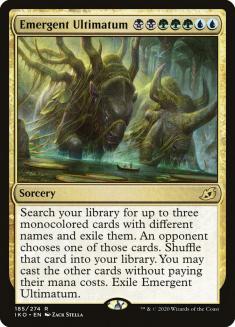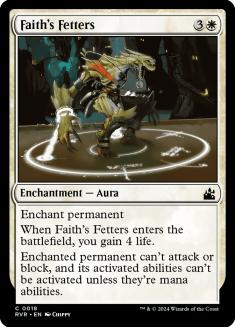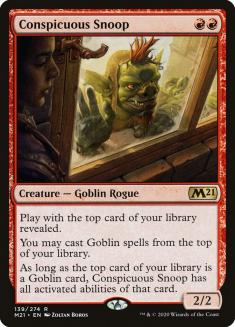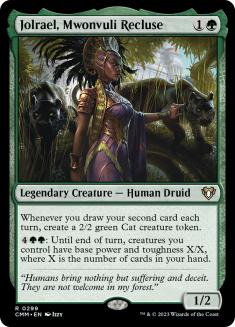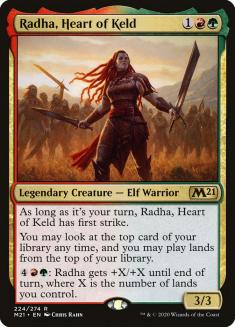Every Standard rotation is met with a mix of joy and relief (which certainly implies that there should be more of them), but this one is just hitting differently. Magic, like the rest of us, has been through some hard times this year. It seems like most folks have identified War of the Spark as the moment where things really went off the rails, and I’m inclined to agree. The static ability planeswalkers have sucked up a lot of oxygen in the room since their printing. While it’s hard to dispute that Throne of Eldraine, which is not rotating, is the most powerful set in current Standard, it does seem like its worst outliers have all hit the bench at this point. This means that the removal of Guilds of Ravnica, Ravnica Allegiance, War of the Spark, and Core Set 2020 should allow some significant change.
The instinct of most players will be to look towards Zendikar Rising to see what new Standard has in store, and I get that. New cards are exciting, and I’ll be right there alongside you tomorrow, refreshing StarCityGames.com to see what my fellow authors think of the previews. There’s some less glamorous work to be done first though, and that’s a review of old sets to see what cards haven’t quite lived up to their potential.
Whether because of slightly better options, hostile metagames, or single-card hosers, some powerful cards have just not had a fair shake thus far in their lifespan. Let’s review our non-rotating sets and see if we can identify some gems ready to break out.
Throne of Eldraine
Giant Killer
When you get mixed up in one of the most powerful Magic sets of all time, it’s tough to stand out and make a name for yourself. Giant Killer has very occasionally dipped a toe into the Standard metagame, but usually as little more than just another one-drop to empower Venerated Loxodon. Giant Killer deserves so much better.
The sheer number of modes on this card are shocking, and that really sums up the core of the Adventure experience. It’s so hard for an average Magic card to be as good as an Adventure creature. They are simultaneously two different cards in one and a source of card advantage. With Giant Killer adding a third very reasonable ability to the mix, its versatility is just off the charts. The only thing that kept smaller adventure creatures like Giant Killer down was the sheer scope of Standard the last few years. Mana was abundant and haymakers were thrown so early that there was no space for smaller Magic cards to occupy.
Giant Killer can be a stand-in for any of the Adventure creatures that have not yet had a moment in the sun or have presently fallen out of favor. If Zendikar Rising Standard is lacking engines like Nissa, Who Shakes the World after rotation, then getting a micro-advantage stapled to every creature will be hard to pass up. The fact that Giant Killer lines up well against the best card remaining in Standard, Uro, Titan of Nature’s Wrath, points to big things in its immediate future.
The Cauldron of Eternity
Hmmm… What was that about Standard lacking engines? In a lot of ways, the best Magic cards will always be those that generate the most mana, real or virtual. The Cauldron of Eternity has a lot of hoops to jump through for a mana return when there are cards like Fires of Invention or Wilderness Reclamation that just double your mana on their face. In the absence of those things, this starts to look realistic again though.
There are basically two huge missing pieces for The Cauldron of Eternity right now. First, it is challenging to reliably enable. Merfolk Secretkeeper desperately wants a quasi-Stitcher’s Supplier to help its goal of filling the graveyard. The other problem is that Standard lacks any impressive reanimation targets. All the large creatures worth playing seem to have escape or mutate.
Something must fill the engine void that rotation will leave behind. Lucky Clover should be one option, as it’s basically a block deck that goes untouched. With some reasonable prints, I could see The Cauldron of Eternity achieving similar things.
Gadwick, the Wizened
I would have bet any amount of money that Gadwick, the Wizened was among the cards rotating in a few weeks. It’s just a card that feels old. Anyway, this is one of those cases where a card benefits from the disappearance of a slightly better option from the format. If you could play Gadwick, the Wizened, you could probably play Hydroid Krasis without much effort. With the payoff of lifegain, a cast trigger, a flying trampling body, and less of a commitment to the color blue, Krasis became the clear occupant of the huge scaling threat slot.
The format retains some solid ramp options in Cultivate and Uro and will need new homes for all that mana. There’s also the possibility of Mono-Blue decks that will be able to leverage Gadwick’s triggered ability and maybe even its deep devotion to the color if Thassa, Deep-Dwelling gets in the mix.
The Castles
I know that this sounds silly in retrospect, but the Castles as a collective occupied my number one slot when I was ranking cards from Throne of Eldraine. Obviously, several banned cards would go on to prove me wrong, but I think the reasoning was solid. The Castles have enough of a payoff that they should have changed the way manabases were built, and the kind of utility they offered on lands really was unprecedented. Instead, castable cards were so inherently powerful that goals focused on consistent casting of broken threats, often in three-color manabases incentivized to play Fabled Passage by Uro or Mayhem Devil. Despite Castles being legit power outliers, there just wasn’t space for them.
While we don’t know what manabases will look like, I can put forth a pretty reductive analysis. Either multicolored manabases get stronger and are better-suited to bear the weight of Castles, or they get worse, and mono- and two-colored decks become the norm with plenty of room for Castles. Of course, this ignores the possibility that new multicolor lands will not have basic land types, but the point is that it’s hard to envision a world where Castles aren’t able to remain a reasonable part of manabases, and there are multiple outcomes that could really make them a focal point of manabases.
Theros Beyond Death
Nyxbloom Ancient
You really can have too much of a good thing. When I was testing Nyxbloom Ancient at the release of Theros Beyond Death, I built some decks that could get up to truly absurd shenanigans.
Creatures (17)
- 1 End-Raze Forerunners
- 4 Paradise Druid
- 2 Arboreal Grazer
- 4 Thunderous Snapper
- 2 Yorvo, Lord of Garenbrig
- 1 Nylea, Keen-Eyed
- 3 Nyxbloom Ancient
Planeswalkers (7)
Lands (4)
Spells (32)

However, it turned out that tripling your mana just wasn’t required when there were so many ways to double your mana lower on the curve. With those cards absent, its possible that the decks that seek to go ludicrously over the top will actually have to abandon some mid-game agency as opposed to having their cake and eating it too. If so, Nyxbloom Ancient might be part of the plan.
Destiny Spinner
Countermagic is slowly reclaiming its role in the format in the absence of Teferi, Time Raveler. For the time being, green decks just haven’t been forced to care. Its two primary threats of Uro and Hydroid Krasis play through countermagic incredibly well. However, if green decks are finally forced away from their safety zone of Simic and towards some other modes of participation, they will find themselves again punished by hearty mana investments. For new modes of green midrange like the aforementioned Nyxbloom Ancient, some bigger Gruul Decks, or Auspicious Starrix-based mutate decks to succeed, there must be a solid sideboard plan.
With Shifting Ceratops finally hitting the bench and Aether Gust headed out along with it, it seems like Destiny Spinner is the best way to get the job done so far. I’m open to other more powerful options, but “can’t be countered” clauses will definitely be trending down at rotation, so we’ll take the best we’ve got.
Field of Ruin
Field of Ruin was a staple in Standard its first go-around and has been an absolute afterthought recently. Again, space in manabases is tight, and three-color decks have been the norm. However, Field of Ruin gets a lot of the same boosts that Castles do and has the possibility of legitimately stunting mana development if multicolor land options are weak.
More importantly, I don’t think we can sleep on the fact that were back on Zendikar. This is the plane where lands matter. Whether Field of Ruin has to kill awakened threats, abuse landfall triggers, or just destroy powerful new lands that get added to the mix, it’s hard to envision a Zendikar Rising that doesn’t make Field of Ruin an important card. Keep this card close in Week 1 deckbuilding.
Ikoria: Lair of Behemoths
Lavabrink Venturer
I keep saying this and I keep feeling like no one is listening. Lavabrink Venturer is way closer to True-Name Nemesis than most people think. It’s another card that has fallen victim to existing in the middle of spectrum. It’s not an engine piece or a giant scaling threat and it doesn’t cost one mana. That means present Standard does not have room for it.
Someone who has believed in Lavabrink Venturer is my friend Yoman_5, who’s been very pleased with the following list that mostly survives rotation.
Creatures (27)
- 4 Kitesail Freebooter
- 4 Knight of the Ebon Legion
- 3 Rankle, Master of Pranks
- 4 General's Enforcer
- 4 General Kudro of Drannith
- 4 Lavabrink Venturer
- 4 Seasoned Hallowblade
Planeswalkers (2)
Lands (17)
Spells (14)

If this deck picks up some quality one- and two-mana threats and a decent two-color land, consider me a believer.
Bastion of Remembrance
Bastion of Remembrance has recently proven its worth in the very powerful Historic format. That should be an eye-opener for everyone doubting its chances of making an impact in Standard. Never underestimate a Blood Artist.
For as long as Woe Strider and its costless sacrifices occupy the same space as Bastion of Remembrance, we’re only a few support pieces away from a viable strategy. Any kind of recursive creature, a few Silversmote Ghouls, and some graveyard velocity, and things will get out of hand very quickly.
Everquill Phoenix
I don’t know if I say this with pride, but I’ve cast far more Everquill Phoenixes than most other Magic players. This card is just solid on rate and has reminded me so much of Rekindling Phoenix. It combines beautifully with any creatures that increase their power and toughness. If landfall buffs make a return in this set, Everquill Phoenix catapulting threats into the air and coming back as a recursive threat will be commonplace. As one of the few mutate creatures that isn’t reliant on multiple mutations to provide adequate value, I’m positive this card is being slept on.
Previously, there was just no space for a non-Simic midrange strategy. If that changes, this card has a real shot.
Emergent Ultimatum
When the powerful sideboard cards of Core Set 2020 were revealed, did anyone anticipate just how dramatically they’d affect the format? Aether Gust has been a maindeck card for over a year now, and the idea of playing any of the Ultimatums has been laughable during most of that time. Thankfully, Aether Gust’s reign of terror is finally coming to an end.
I think Emergent Ultimatum has the highest potential upside of any of the Ultimatums. If the right mix of monocolored cards enters the format at any point in time, this should equate to a seven-mana “win the game.” Cultivate and Uro will need some new friends, and they play better with Emergent Ultimatum than Genesis Ultimatum.
Core Set 2021
Faith’s Fetters
Again, Faith’s Fetters strikes me as a reasonable card for the current metagame — it’s just that there’s no reason to play non-Simic midrange. The versatility here is pretty unmatched, and I’d again give Faith Fetters extra points headed into Zendikar Rising for its ability to answer any problematic lands that pop up.
Conspicuous Snoop
There are Goblins on Zendikar. I love Conspicuous Snoop. This is sheer optimism. Let me have this.
Jolrael, Mwonvuli Recluse
Jolrael, Mwonvuli Recluse stood out to me as the Core Set 2021 card most capable of spawning its own archetype long term. Last week, Autumn Burchett showed we were already much closer than most people expected.
Creatures (12)
Planeswalkers (3)
Lands (24)
Spells (21)
Sideboard

Much of this deck is staying intact upon rotation, and it’s probably one of the clearest homes for one of the first new Zendikar Rising cards — Jace, Mirror Mage.
The templating on Jace, Mirror Mage seems almost tailor-made to enable Jolrael to get a trigger off its activation. There are also solid secondary payoffs for drawing two lurking in Throne of Eldraine. Irencrag Pyromancer, Improbable Alliance, and even Faerie Vandal strike me as reasonable inclusions here. Again, a deck that should benefit by greater space in the middle of the metagame.
Radha, Heart of Keld
Does everyone remember Courser of Kruphix and how important it was during its time in Standard? It was even powerful enough to reach back to Modern and Legacy in limited numbers. In some ways, Radha, Heart of Keld offers more. A potentially game-ending threat on its own at any stage of the game, it just seems like this was the card that Gruul Midrange was supposed to be built around. Post-rotation, it should get another chance.
Zendikar Is Rising
It feels like this is one of the most important rotations in Magic’s history. It is the chance to turn the corner on a problematic era of Standard and get back to the style of gameplay Standard has historically been about. The list of cards that have been invalidated by the strength of Simic is almost comically long. There easily could have been dozens more entrants on this list, but at some point, the talking points started to look the same.
Engines were better than everything else, and when they were finally shut down, no other form of midrange (or maybe any deck) could realistically compete with the combination of Nissa, Who Shakes the World; Hydroid Krasis; and Uro, Titan of Nature’s Wrath. I continue to be trepidatious about Uro’s continued presence in the format. However, improved graveyard hate, challenging mana, and any other number of factors could still serve to limit Uro’s impact on new Standard. If so, there are a lot of exciting options from the past year to revisit.
When these cards combine with the Zendikar Rising previews we’ll be covering for the next few weeks, I’m hopeful that Standard will be able to right the ship.

